Peiming Li
ReSeek: A Self-Correcting Framework for Search Agents with Instructive Rewards
Oct 01, 2025



Abstract:Search agents powered by Large Language Models (LLMs) have demonstrated significant potential in tackling knowledge-intensive tasks. Reinforcement learning (RL) has emerged as a powerful paradigm for training these agents to perform complex, multi-step reasoning. However, prior RL-based methods often rely on sparse or rule-based rewards, which can lead agents to commit to suboptimal or erroneous reasoning paths without the ability to recover. To address these limitations, we propose ReSeek, a novel self-correcting framework for training search agents. Our framework introduces a self-correction mechanism that empowers the agent to dynamically identify and recover from erroneous search paths during an episode. By invoking a special JUDGE action, the agent can judge the information and re-plan its search strategy. To guide this process, we design a dense, instructive process reward function, which decomposes into a correctness reward for retrieving factual information and a utility reward for finding information genuinely useful for the query. Furthermore, to mitigate the risk of data contamination in existing datasets, we introduce FictionalHot, a new and challenging benchmark with recently curated questions requiring complex reasoning. Being intuitively reasonable and practically simple, extensive experiments show that agents trained with ReSeek significantly outperform SOTA baselines in task success rate and path faithfulness.
UST-SSM: Unified Spatio-Temporal State Space Models for Point Cloud Video Modeling
Aug 20, 2025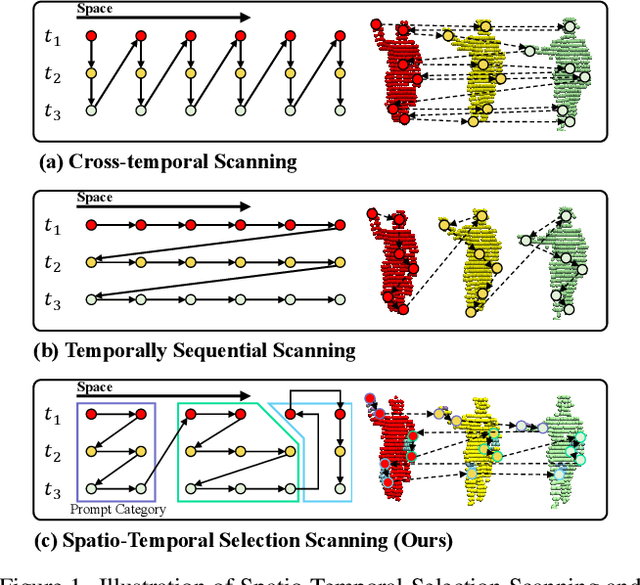
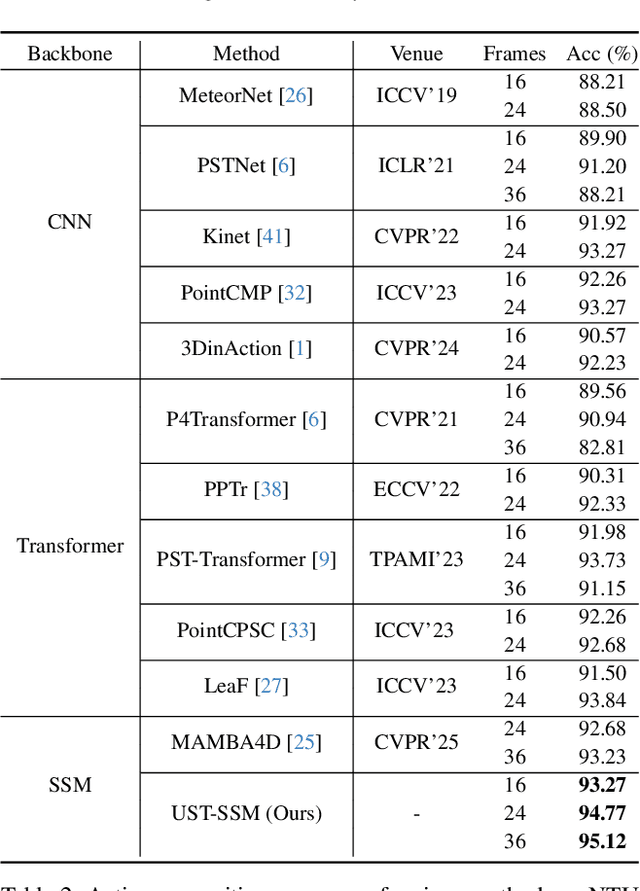
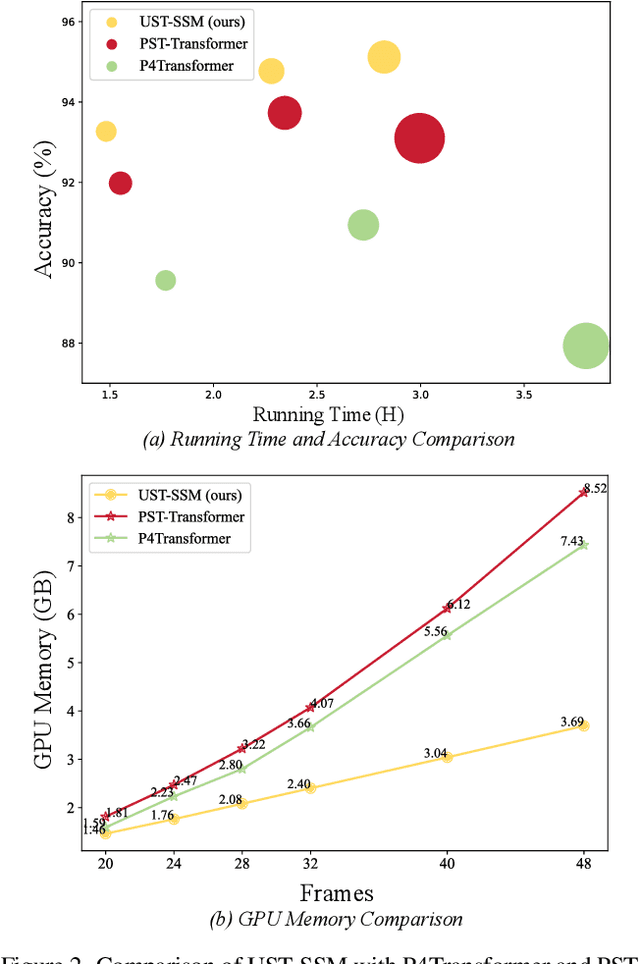
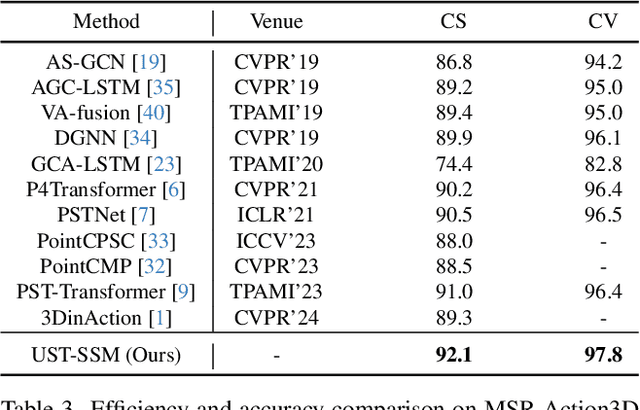
Abstract:Point cloud videos capture dynamic 3D motion while reducing the effects of lighting and viewpoint variations, making them highly effective for recognizing subtle and continuous human actions. Although Selective State Space Models (SSMs) have shown good performance in sequence modeling with linear complexity, the spatio-temporal disorder of point cloud videos hinders their unidirectional modeling when directly unfolding the point cloud video into a 1D sequence through temporally sequential scanning. To address this challenge, we propose the Unified Spatio-Temporal State Space Model (UST-SSM), which extends the latest advancements in SSMs to point cloud videos. Specifically, we introduce Spatial-Temporal Selection Scanning (STSS), which reorganizes unordered points into semantic-aware sequences through prompt-guided clustering, thereby enabling the effective utilization of points that are spatially and temporally distant yet similar within the sequence. For missing 4D geometric and motion details, Spatio-Temporal Structure Aggregation (STSA) aggregates spatio-temporal features and compensates. To improve temporal interaction within the sampled sequence, Temporal Interaction Sampling (TIS) enhances fine-grained temporal dependencies through non-anchor frame utilization and expanded receptive fields. Experimental results on the MSR-Action3D, NTU RGB+D, and Synthia 4D datasets validate the effectiveness of our method. Our code is available at https://github.com/wangzy01/UST-SSM.
Recognizing Actions from Robotic View for Natural Human-Robot Interaction
Jul 30, 2025



Abstract:Natural Human-Robot Interaction (N-HRI) requires robots to recognize human actions at varying distances and states, regardless of whether the robot itself is in motion or stationary. This setup is more flexible and practical than conventional human action recognition tasks. However, existing benchmarks designed for traditional action recognition fail to address the unique complexities in N-HRI due to limited data, modalities, task categories, and diversity of subjects and environments. To address these challenges, we introduce ACTIVE (Action from Robotic View), a large-scale dataset tailored specifically for perception-centric robotic views prevalent in mobile service robots. ACTIVE comprises 30 composite action categories, 80 participants, and 46,868 annotated video instances, covering both RGB and point cloud modalities. Participants performed various human actions in diverse environments at distances ranging from 3m to 50m, while the camera platform was also mobile, simulating real-world scenarios of robot perception with varying camera heights due to uneven ground. This comprehensive and challenging benchmark aims to advance action and attribute recognition research in N-HRI. Furthermore, we propose ACTIVE-PC, a method that accurately perceives human actions at long distances using Multilevel Neighborhood Sampling, Layered Recognizers, Elastic Ellipse Query, and precise decoupling of kinematic interference from human actions. Experimental results demonstrate the effectiveness of ACTIVE-PC. Our code is available at: https://github.com/wangzy01/ACTIVE-Action-from-Robotic-View.
ClickDiff: Click to Induce Semantic Contact Map for Controllable Grasp Generation with Diffusion Models
Jul 28, 2024



Abstract:Grasp generation aims to create complex hand-object interactions with a specified object. While traditional approaches for hand generation have primarily focused on visibility and diversity under scene constraints, they tend to overlook the fine-grained hand-object interactions such as contacts, resulting in inaccurate and undesired grasps. To address these challenges, we propose a controllable grasp generation task and introduce ClickDiff, a controllable conditional generation model that leverages a fine-grained Semantic Contact Map (SCM). Particularly when synthesizing interactive grasps, the method enables the precise control of grasp synthesis through either user-specified or algorithmically predicted Semantic Contact Map. Specifically, to optimally utilize contact supervision constraints and to accurately model the complex physical structure of hands, we propose a Dual Generation Framework. Within this framework, the Semantic Conditional Module generates reasonable contact maps based on fine-grained contact information, while the Contact Conditional Module utilizes contact maps alongside object point clouds to generate realistic grasps. We evaluate the evaluation criteria applicable to controllable grasp generation. Both unimanual and bimanual generation experiments on GRAB and ARCTIC datasets verify the validity of our proposed method, demonstrating the efficacy and robustness of ClickDiff, even with previously unseen objects. Our code is available at https://github.com/adventurer-w/ClickDiff.
Channel Knowledge Map (CKM)-Assisted Multi-UAV Wireless Network: CKM Construction and UAV Placement
Jul 05, 2022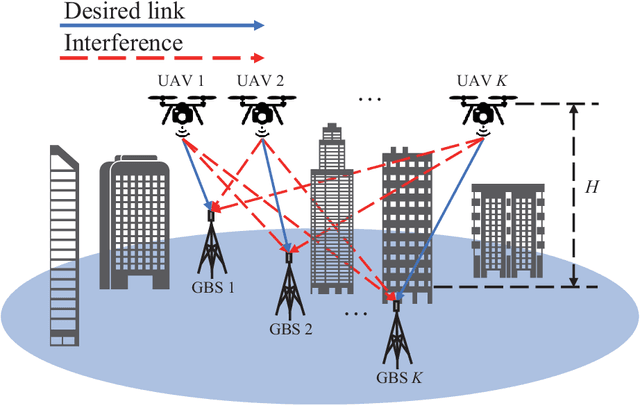
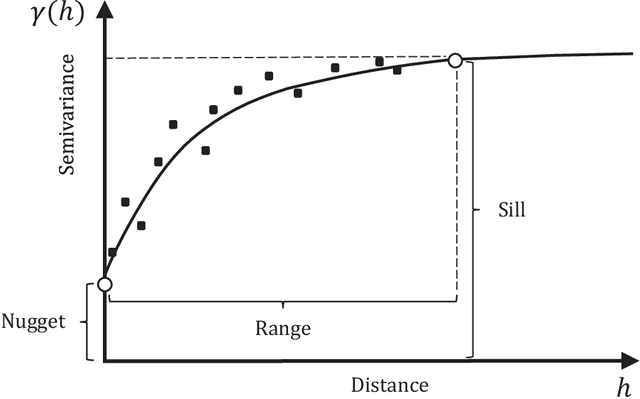


Abstract:Channel knowledge map (CKM) has recently emerged to facilitate the placement and trajectory optimization for unmanned aerial vehicle (UAV) communications. This paper investigates a CKM-assisted multi-UAV wireless network, by focusing on the construction and utilization of CKMs for multi-UAV placement optimization. First, we consider the CKM construction problem when data measurements for only a limited number of points are available. Towards this end, we exploit a data-driven interpolation technique to construct CKMs to characterize the signal propagation environments. Next, we study the multi-UAV placement optimization problem by utilizing the constructed CKMs, in which the multiple UAVs aim to optimize their placement locations to maximize the weighted sum rate with their respectively associated ground base stations (GBSs). However, the rate function based on the CKMs is generally non-differentiable. To tackle this issue, we propose a novel iterative algorithm based on derivative-free optimization, in which a series of quadratic functions are iteratively constructed to approximate the objective function under a set of interpolation conditions, and accordingly, the UAVs' placement locations are updated by maximizing the approximate function subject to a trust region constraint. Finally, numerical results are presented to validate the proposed design achieves near-optimal performance, but with much lower implementation complexity.
 Add to Chrome
Add to Chrome Add to Firefox
Add to Firefox Add to Edge
Add to Edge